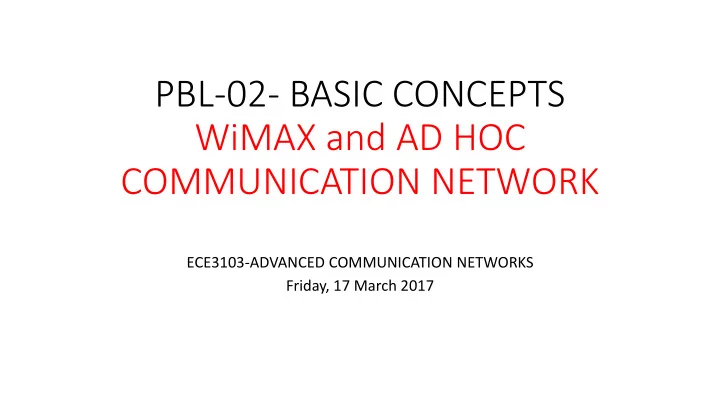

PBL-02- BASIC CONCEPTS WiMAX and AD HOC COMMUNICATION NETWORK ECE3103-ADVANCED COMMUNICATION NETWORKS Friday, 17 March 2017
1. WiMAX is short for W orldwide I nteroperability for M icrowave A ccess. 2. WiMAX is a metropolitan wireless standard created by the companies Intel and Alvarion in 2002 and ratified by the IEEE (Institute of Electrical and Electronics Engineers) under the standard IEEE-802.16. Further Reading: 1. Review Paper - A Comprehensive Review on WiMAX Networks 2. IEEE Communication Magazine - Mobile WiMAX Systems: Performance and Evolution
Further Reading: 1. Journal Paper: Augmenting Mobile 3G Using WiFi 2. Journal Paper: Wireless Internet Access-3G Vs WiFi
WiMAX, 802.16 standard offers two forms of duplex transmission to separate the uplink and downlink messages,i.e 1. WiMAX TDD (time division duplex) by sharing the same frequency for uplink and downlink but transmitting at different times. 2. WiMAX FDD (frequency division duplex) using two channels or paired spectrum, i.e uplink and downlink Further Reading: Vecima Networks: Duplexing Techniques in WiMAX Journal paper: Adaptive Downlink and Uplink Channel Split Ratio Determination for TCP-Based Best Effort Traffic in TDD -Based WiMAX Networks
Further Reading: Survey Paper on Researchgate - A Survey of Mobile WiMax
Further Reading: 1. Fundamentals of WiMAX – Understanding Broadband Wireless Networking by Jeffrey 2. Journal Paper- The Future of WiMAX
Further Reading: WiFi Tutorial - http://ece3103.elimu.net/Notes/WiFi/wifi_tutorial.pdf
Further Reading: 1. https://www.tutorialspoint.com/wimax/wimax_physical_layer.htm 2. Journal Paper: Comparative Study of Digital Modulation Techniques in WIMAX - https://pdfs.semanticscholar.org/2a15/a9a728af9e0e9376e31c60d0e4668b7592ff.pdf
Further Reading: 1. WiFi Alliance Website - http://www.wi-fi.org/discover-wi-fi/specifications 2. Down load standard at IEEE Standards Association - http://standards.ieee.org/about/get/802/802.11.html
The WiMAX MAC layer provides an interface between the higher transport layers and the physical layer. It takes packets from the upper layer, these packets are called MAC service data units (MSDUs) and organizes them into MAC protocol data units (MPDUs) for transmission over the air. Further Reading: http://www.eetimes.com/document.asp?doc_id=1271996
Further Reading 1. http://citeseerx.ist.psu.edu/viewdoc/download?doi=10.1.1.116.4941&rep=rep1&type=pdf 2. http://boundless.aerohive.com/experts/wi-fi-back-to-basics--24-ghz-channel-planning.html
Further Reading: Review M.Sc paper – Advanced Encryption Standard
• WiFi receiver accuracy is usually expressed in dBm and is taken to be -70dBm. • However, -70dbM is the same as 90-70 = 15dBrn. Further Reading http://www.gigabit-wireless.com/gigabit-wireless/802-11ac-technology-gigabit- wireless/
WiFi RECEIVER SENSITIVITY
WiFi ATTENUATION THROUGH DIF IFFERENT MATERIALS/1
WiFi ATTENUATION THROUGH DIF IFFERENT MATERIALS/2
Further Reading: Review Journal Paper - VOIP Over Wimax: A Comprehensive Review
1. 802.11 Wi-Fi systems transmit in the 2.4 GHz band with a total of fourteen available channels. 2. In Europe and Africa , only thirteen of those channels are legally available. 3. In the US only eleven of those channels are legally available. Further Reading http://boundless.aerohive.com/experts/wi-fi-back-to-basics--24-ghz-channel-planning.html
• Different bands are available for WiMAX applications in different parts of the world. • The frequencies commonly used are 3.5 and 5.8 GHz for 802.16d and 2.3, 2.5 and 3.5 GHz for 802.16e
FURTHER READING 1. Journal Paper - Wired equivalent privacy (WEP) versus Wi-Fi protected access (WPA) 2. White Paper - Wi-Fi Protected Access: Strong, standards-based, interoperable security for today’s Wi -Fi networks
Further Reading: Journal paper- Decentralized Access Point Selection Architecture for Wireles LANs
Further Reading: Review Paper – A Brief Overview of Ad Hoc Networks- Challenges and Directions
FURTHER READING Journal Paper - Performance Evaluation and Enhancement of the CSMA/CA MAC Protocol for 802.11 Wireless LAN.
1. OFDM is a frequency-division multiplexing (FDM) scheme used as a digital multi-carrier modulation method. 2. A large number of closely spaced orthogonal sub-carrier signals are used to carry data on several parallel data streams or channels.
NOTES 1. Over a wired medium, e.g. Ethernet cable it is possible to detect a collision (CD) by measuring the power level on the medium itself. 2. Measuring the power level in a RF environment is not possible with the precision required to detect a packet collision. 3. Collision detection is therefore not normally used. In IEEE 802.11 Collision avoidance is used. 4. Collision detection would allow a network to have better performances than what it is possible to accomplish with Collision Avoidance, which requires acknowledgement packets and therefore create overhead. 5. The other alternative to CSMA/CD is TDMA based approached to medium access control.
1. The goals of WEP is to prevent unauthorized users from gaining access to the network. 2. Privacy is obtained by using the WEP key to encrypt the WLAN data streams and only those with the correct WEP key can decrypt them.
FURTHER READING 1. Journal paper - Performance Analysis of the IEEE 802.11 Distributed Coordination Function 2. Journal paper - IEEE 802.11 Distributed Coordination Function(DCF): Analysis and Enhancement 3. Journal paper - Performance Evaluation and Enhancement of the CSMA/CA MAC Protocol for 802.11 Wireless LANs 4. Journal paper - Performance Analysis of IEEE 802.11 CSMA/CA Medium Access Control Protocol
1. TKIP (Temporal Key Integrity Protocol) is an encryption protocol included as part of the IEEE 802.11 standard for wireless LANs (WLANs) 2. It was designed to provide more secure encryption than the weak Wired Equivalent Privacy (WEP), the original WLAN security protocol. FURTHER READING 1. Journal Paper - A Survey on Wireless Security protocols(WEP, WPAand WPA2/802.11i) 2. Journal Paper - Wired Equivalent Privacy (WEP) versus Wi-Fi Protected Access (WPA)
1. Wi-Fi (over IEEE 802.11) ZigBee standard (IEEE 802.15.4) is a set of specifications for Wireless Personal Area Networking (WPAN), i.e., digital radio connections between computers and related devices, e.g telephone, sensors etc located within a few metres of each other. 2. Protocol standards for short-range wireless communications with low power consumption: a) WiFi (802.11) b) Bluetooth (IEEE 802.15.1), c) ultra-wideband (UWB, IEEE 802.15.3), d) ZigBee (IEEE 802.15.4) FURTHER READING 1. Journal Paper - Wireless sensor networks: A survey on the state of the art and the 802.15. 4 and ZigBee standards 2. Journal Paper - A comparative study of wireless protocols: Bluetooth, UWB, ZigBee, and Wi-Fi
Recommend
More recommend